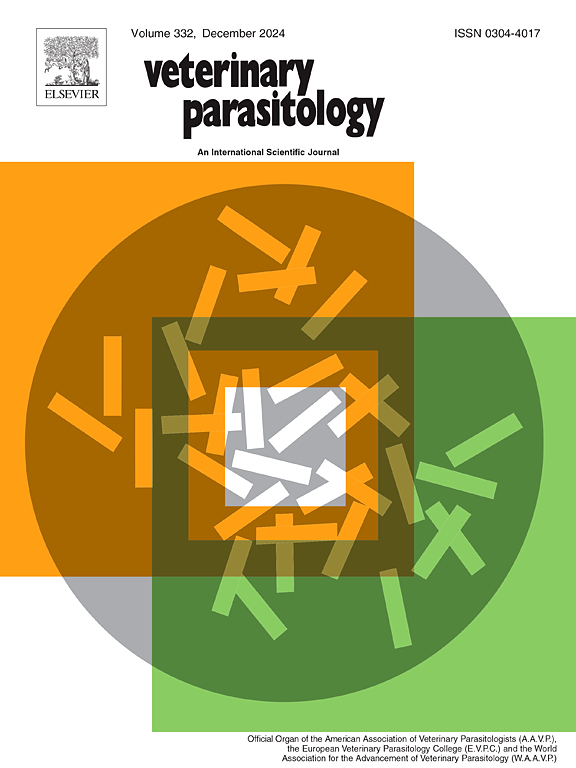Intestinal helminths in farmed pacu (Piaractus mesopotamicus): Hematological and histopathological effects
IF 2.2
2区 农林科学
Q2 PARASITOLOGY
引用次数: 0
Abstract
Biosecurity in aquaculture is essential to reduce disease burden and ensure sustainability. Piaractus mesopotamicus (pacu) is a key species in South American aquaculture, yet parasitic threats to its health remain understudied. We analyzed intestinal helminth and assessed their effects on the health of 34 farmed pacu reared in intensive and semi-intensive systems in Santa Fe, Argentina, using parasitological, hematological, and histopathological approaches. Three parasite taxa were identified: the digenean Dadaytrema oxycephala (∼65 % prevalence; mean abundance: ∼3 parasites/fish), the nematode Rondonia rondoni (3 % prevalence; one host with 119 parasites), and the acanthocephalan Echinorhynchus jucundus (100 % prevalence; mean abundance: ∼235 parasites/fish). E. jucundus caused macrocytic hypochromic anemia (low erythrocyte count and hemoglobin, high MCV) and severe intestinal lesions (muscle penetration and chronic inflammation). D. oxycephala had marginal hematological effects. Infestations likely originated in land-based ponds, where zooplankton hosts thrive in the absence of technical biosecurity measures. Despite the high parasite burden, infected fish maintained stable body condition, suggesting a degree of physiological tolerance. However, the risk of nutrient malabsorption and market rejection remains. We propose: (1) prevention measures such as ≥ 15-day quarantine, pond sterilization, zooplankton monitoring in semi-intensive systems, water quality control in intensive systems, and necropsy of samples in cases of low feed conversion; (2) corrective action via targeted anthelmintic treatment or culling during outbreaks (>50 parasites/gut). This study identifies E. jucundus as an emerging pathogenic parasite and highlights the need for tailored biosecurity protocols adapted to different production systems, promoting the sustainable culture of pacu.
养殖帕库(Piaractus mesopotamicus)肠道蠕虫:血液和组织病理学效应
水产养殖中的生物安全对于减轻疾病负担和确保可持续性至关重要。美索不达米亚河鼠(Piaractus mesopotamicus, pacu)是南美洲水产养殖的重要物种,但寄生虫对其健康的威胁仍未得到充分研究。我们利用寄生虫学、血清学和组织病理学方法,分析了阿根廷圣达菲集约化和半集约化养殖系统中34只帕库鱼的肠道蠕虫,并评估了它们对健康的影响。鉴定出3个寄生虫类群:digenean Dadaytrema oxycephala(~ 65 %患病率);平均丰度:~ 3个寄生虫/鱼),Rondonia rondoni线虫(3 %患病率;1个寄主有119个寄生虫)和棘头棘喙棘虫(100 %;平均丰度:约235个寄生虫/条)。巨念珠菌引起大细胞性低色素贫血(红细胞计数和血红蛋白低,MCV高)和严重的肠道病变(肌肉渗透和慢性炎症)。氧头草对血液有轻微的影响。感染可能起源于陆地池塘,在缺乏技术生物安全措施的情况下,浮游动物宿主在那里茁壮成长。尽管寄生虫负担高,但受感染的鱼保持稳定的身体状况,表明一定程度的生理耐受。然而,营养吸收不良和市场排斥的风险仍然存在。我们建议:(1)采取≥ 15天隔离、池塘消毒、半集约化系统浮游动物监测、集约化系统水质控制、饲料转化率低时标本尸检等预防措施;(2)通过有针对性的驱虫治疗或在疫情期间扑杀采取纠正措施(50种寄生虫/肠道)。本研究确定了巨齿弓形虫是一种新兴的致病性寄生虫,并强调需要制定适合不同生产系统的量身定制的生物安全方案,以促进pacu的可持续发展。
本文章由计算机程序翻译,如有差异,请以英文原文为准。
求助全文
约1分钟内获得全文
求助全文
来源期刊

Veterinary parasitology
农林科学-寄生虫学
CiteScore
5.30
自引率
7.70%
发文量
126
审稿时长
36 days
期刊介绍:
The journal Veterinary Parasitology has an open access mirror journal,Veterinary Parasitology: X, sharing the same aims and scope, editorial team, submission system and rigorous peer review.
This journal is concerned with those aspects of helminthology, protozoology and entomology which are of interest to animal health investigators, veterinary practitioners and others with a special interest in parasitology. Papers of the highest quality dealing with all aspects of disease prevention, pathology, treatment, epidemiology, and control of parasites in all domesticated animals, fall within the scope of the journal. Papers of geographically limited (local) interest which are not of interest to an international audience will not be accepted. Authors who submit papers based on local data will need to indicate why their paper is relevant to a broader readership.
Parasitological studies on laboratory animals fall within the scope of the journal only if they provide a reasonably close model of a disease of domestic animals. Additionally the journal will consider papers relating to wildlife species where they may act as disease reservoirs to domestic animals, or as a zoonotic reservoir. Case studies considered to be unique or of specific interest to the journal, will also be considered on occasions at the Editors'' discretion. Papers dealing exclusively with the taxonomy of parasites do not fall within the scope of the journal.
 求助内容:
求助内容: 应助结果提醒方式:
应助结果提醒方式:


